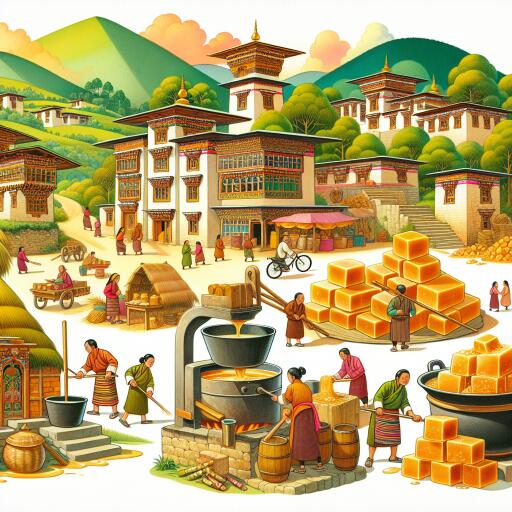Jaggery Business in Lumang Gewog Picks Up
In the serene landscapes of Lumang Gewog, a significant transformation is underway. The traditional art of jaggery making, known as “tshatshi buram” among the locals, is witnessing a revival. This resurgence is largely fueled by an increasing number of farmers turning their fields over to sugarcane cultivation, a trend that promises to reshape the local economy in the years to come.
Sugarcane cultivation is slowly becoming a preferred agricultural activity over traditional crops like maize. This shift is attributed to the higher income it generates. Farmers like Wangdi from Dhoree village are pioneers in this venture. With more than a decade of experience, Wangdi navigated through early challenges to establish a successful sugarcane farm. He concedes that making jaggery is a labor-intensive process requiring the boiling of raw sugarcane juice until it solidifies. Nonetheless, he has embraced the rigorous lifestyle, adopting strategies such as intercropping to enhance sugarcane productivity.
Similarly, Lobzang Dorji’s journey in the sugarcane business started on a modest scale with just a small plot. Over time, recognizing the potential for substantial profit and economic independence, he expanded his plantation. His endeavor paid off, with earnings exceeding Nu 20,000 from jaggery sales alone last year, showcasing the lucrative nature of this venture.
Embracing the potential of sugarcane, over 50 households within the gewog have embarked on its cultivation. The gewog administration has played a supportive role by providing juice extraction machines to aid in the production process. Despite this, some farmers continue to rely on manual extraction methods. These traditional techniques, while laborious and time-consuming, are still favored by a segment of the community.
But as interest in sugarcane cultivation grows, there is an evident demand for more efficient, modern machinery. Dorji Wangchuk, who operates one of the machines, calls on the government for assistance in acquiring advanced technology to make the extraction process more efficient. This move is seen as essential for scaling up production and increasing profitability.
The sugarcane venture not only represents a significant source of income for the villagers but also holds the promise of uplifting Lumang Gewog’s economy. Gup Sangay Gyeltshen, a local leader, is optimistic about the future. He outlines plans to enhance marketing strategies and provide farmers with training on packaging. This initiative is aimed at maximizing profitability and ensuring that the benefits of sugarcane cultivation reach as many people as possible.
As Lumang Gewog harnesses the potential of sugarcane to drive economic growth, the community stands on the brink of a new era of prosperity. Through a combination of traditional knowledge and modern technology, together with a strong support system, the jaggery business is set to become a cornerstone of the local economy. The focus on sustainable agricultural practices not only promises an increase in income for the farmers but is also a step forward in the ongoing efforts to reduce poverty rates in the region.
